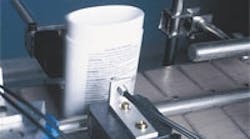Integrating sensors and vision systems with motion is common in assembly applications; less so in packaging. But that’s beginning to change.
As with other areas of manufacturing, efforts at improving quality are having a big impact on packaging technology. As line speeds get faster, product must get into its package with minimal error. Sensors and vision systems can assure that the right product is in the right package, in the right orientation, and with the right labeling information.
One less bottleneck
When it comes to motion applications, the speed at which a sensor or vision system detects an object is no longer the issue it was a few years ago. The reason: Sensor manufacturers are taking advantage of miniaturization and optical technologies to develop products that can routinely detect over 1,400 objects/minute. For comparison, previous sensing rates were 300 to 400 objects/ minute.
Response rates of sensors have improved too. Some of the newer photoelectric sensors respond in as little as 0.02 msec when detecting features on the order of 20 microns or so.
If an application moves objects at faster speeds, the typical solution is a vision system. These sensing devices, usually a more expensive choice, detect objects moving at speeds ranging from 2,000 to over 12,000/ min. In addition, digitalbased vision systems can achieve realtime (microsecond) response rates.
Thus, says one application engineer, most system designers don’t worry about the speed of the motor-drive because sensing speed is no longer the bottleneck. As a result, designers can now focus on product orientation and alignment, whether it’s relative to the production line or the package.
Towards better positioning
As technology improves, making it possible to develop smaller products with tighter tolerances, new concerns crop up. Laser sensors, for example, can measure objects or parts of objects as small as 0.01 in. But to fully use the tight focus and faster speeds, object orientation is crucial.
To deal with orientation problems, some packaging systems use sensors in combination with actuation devices. In some simple sensor-actuator combinations, the sensor signal may cause an actuator or linear slide to move the object a predetermined amount. A more common application is coordinating with an ejection motion system, such as an actuator or linear slide. The sensor, set up to detect a specific flaw, sends a signal to the ejection system, which moves to eject the defective object from the line.
One potential flaw is an incorrect label. Labels are an indispensable packaging component in food, consumer product, and pharmaceutical industries. A wrong label, especially on medicine, is grounds for legal action. But with packaging line speeds increasing, manual label inspection is impossible. Sample inspection can also be inadequate because defective labels may get through the process. Vision systems are an alternative that can provide 100% inspection.
Whether labels are inspected before or after being placed on products, whether they’re printed using ink-jet or hotstamping methods, and whether or not the labels are skewed, vision sensing can catch and offer fixes for all defects prior to shipment.
In more complex sensor-motion coordination arrangements, sensors may provide data for microprocessor-based controllers, which then issue commands to pick-andplace units to twist, turn, or otherwise properly align the objects. The recent development of device-level buses provides the communication necessary to coordinate such actions between sensing devices and motion systems.
Continue on page 2
In one application, for example, a bowl-feeder drops small electronic chips into a channel in such a way that they are lined up, one after another. A small pick-and-place robot with a vision system must then pick the chip and place it in a tape carrier, which is sealed afterward. As the robot places a chip into each package, the vision system looks at the next chip to determine its orientation. If the chip is skewed, upsidedown, or angled wrong, the vision system software instructs the robot to turn the chip so that it can be placed in the package correctly. The robot servos, handling the stop and start motion, must adjust quickly to the instructions from the vision system to maintain throughput.
Another example is a bottle filling station. One company uses a timing screw to feed bottles into the filling station. Horizontally placed, the screw is a device similar to a threaded leadscrew. A motor turns it and controls its speed. The bottles catch the threads of the screw, which then propels them down the line as it turns. Sensors on the inbound and outbound sides of the filling station signal the drive to speed up or slow down, depending on the spacing between the empty bottles.
Added benefits
Other potential effects from integrated sensing and motion systems on packaging equipment include:
• Engineers no longer have to choose between operating at full speed and risk defective parts getting through, or operating at slower speeds to find all defective parts.
• Packaging equipment can handle bigger loads. Even though accuracy usually goes down as the load increases, sensing devices will still find 100% of all rejects.
• Such systems make it easier to synchronize machines with different productivity rates. Integrated sensing and motion systems can adjust the output between machines, resulting in smoother product flow.




